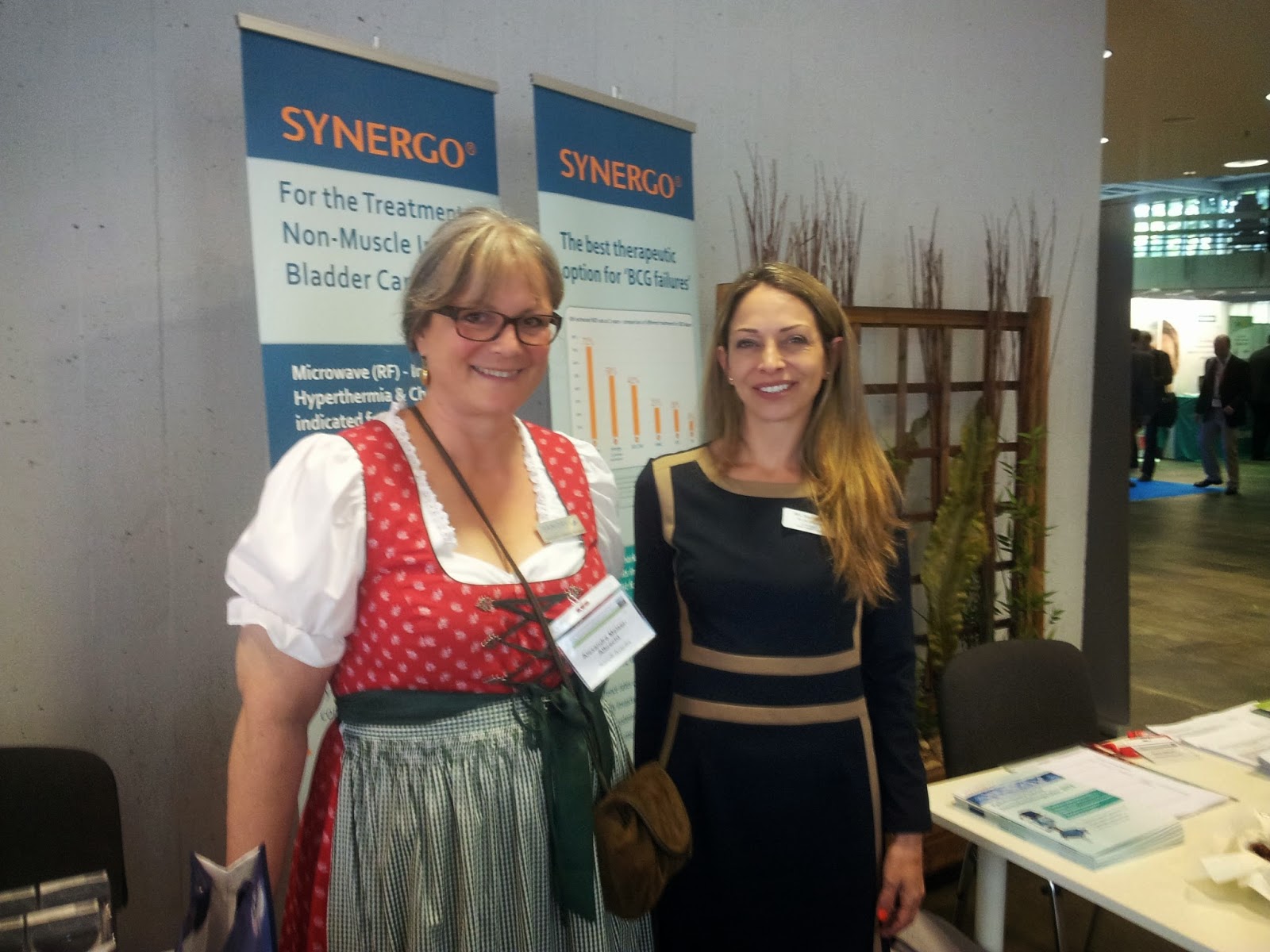What is RITE (Radiofrequency-Induced Thermo-chemotherapy Effect) for bladder cancer?
Hyperthermia is being used in many medical fields.
 Synergo® uses a unique combination of local microwave energy hyperthermia (heating) with simultaneous instillation of cooled chemotherapeutic drug. The target of hyperthermia is to reach effective temperature inside the tissue to enable higher drug penetration and accelerate drug-DNA reactions.
Synergo® uses a unique combination of local microwave energy hyperthermia (heating) with simultaneous instillation of cooled chemotherapeutic drug. The target of hyperthermia is to reach effective temperature inside the tissue to enable higher drug penetration and accelerate drug-DNA reactions.
Tissue heating should be adjusted per patient and dynamically maintained during treatment while the tissue temperature is constantly measured and closely followed.
Conduction is governed by the Boltzmann equation: Heat conduction is proportional to a constant K which cannot be changed: (for example: Kfat=0.2, Kmuscle=0.38, Ksilver=420)
Since the bladder wall acts as a good thermal insulator, heat penetration from heated liquid is not efficient (conduction/convection heating). On the other hand, during microwave heating the energy is absorbed directly deep in the tissue to enable efficient homogeneous heating, real-time measurement and follow-up on the tissue temperature and dynamic adjustment of the transmitted energy for each per patient over time (e.g. when blood flow in tissue is increased due to heating).
Warm liquid does not allow any simple adjustments in order to tailor heating per patient over time (e.g. different patients have different blood circulation, different tissues, dynamic changes that occur over time such as vasodilation etc.)
Moving from hot liquid to microwave radiation in the Synergo® systems was based on previous experience, as well as on articles already published by other researchers.
Richmond A. Owusu et. al describes the effect and mechanism of hyperthermia together with intravescical chemotherapy in his recently published paper (Owusu et al. 2013)."HT has cytotoxic effects on tumour cells via several mechanisms including improved anti-tumour immunity and by direct cytotoxic effects. Heat plays a role in causing cytotoxicity to tumours (additive effect), enhancing drug toxicity to tumours (synergistic effect), and thermosensitization by noncytotoxic drugs....”
Studies, showing the effect of the Synergo® RITE were performed in the 90's by Paroni et.al. (Paroni et al. 1997; Paroni et al. 2001). The findings indicated the clinical effectiveness benefits of RF hyperthermia associated with chemotherapy. The marked effect on bladder wall permeability resulted in enhanced MMC penetration through the urothelium and the tissue layers. It also showed that the dose administered in the Synergo treatment with hyperthermia, consisting of two 30-minute dwell periods of 20 mg MMC each, actually represented a total dose of not less than 40 mg for the 60 minutes treatment. The same study also showed that the MMC solution is not affected by the RITE method.
The re-fueling of the bladder with a fresh instillation of 20 mg MMC solution (following 30 minutes of treatment) after the bladder is drained of residual urine – eliminates the dilution of the drug with urine and thereby maintains a more optimal and homogeneous drug dose throughout the entire treatment duration. This technique also minimizes the inter-patient variability of parameters such as concentration in residual urine and bladder MMC concentration.
Another study made on animals, showed that indeed bladder walls are heated while adjacent organs are not (Rath-Wolfson et al. 2003). It also showed the evenly distributed heating and that the thermometers of the Synergo® reflect faithfully and accurately the temperature of the tissue and not of the liquid in the bladder vault.
In a 2004 study van der Heijden at al. assessed the effect of hyperthermia on mitomycin C-induced cytotoxicity in bladder cancer cell lines (van der Heijden et al. 2004) showing a decrease in cell proliferation after treatment with increasing concentrations MMC. The apparent synergy of chemotherapeutics and hyperthermia was further addressed by the same group demonstrating a similar phenomenon for epirubicin, EO9, mitomycin C and, to a lesser extent, gemcitabine (van der Heijden et al. 2005).
Owusu RA, Abern MR, Inman BA. 2013. Hyperthermia as Adjunct to Intravesical Chemotherapy for Bladder Cancer. BioMed Research International 2013: 7. Paroni R, Arcelloni C, De Vecchi E, Fermo I, Mauri D, Colombo R. 1997. Plasma mitomycin C concentrations determined by HPLC coupled to solid-phase extraction. Clinical chemistry 43: 615-618. Paroni R, Salonia A, Lev A, Da Pozzo LF, Cighetti G, Montorsi F, Rigatti P, Colombo R. 2001. Effect of local hyperthermia of the bladder on mitomycin C pharmacokinetics during intravesical chemotherapy for the treatment of superficial transitional cell carcinoma. British journal of clinical pharmacology 52: 273-278. Rath-Wolfson L, Moskovitz B, Dekel Y, Kugel V, Koren R. 2003. Combined intravesical hyperthermia and mitomycin chemotherapy: a preliminary in vivo study. International journal of experimental pathology 84: 145-152. van der Heijden AG, Jansen CF, Verhaegh G, O'Donnell M A, Schalken JA, Witjes JA. 2004. The effect of hyperthermia on mitomycin-C induced cytotoxicity in four human bladder cancer cell lines. European urology 46: 670-674. van der Heijden AG, Verhaegh G, Jansen CF, Schalken JA, Witjes JA. 2005. Effect of hyperthermia on the cytotoxicity of 4 chemotherapeutic agents currently used for the treatment of transitional cell carcinoma of the bladder: an in vitro study. The Journal of urology 173: 1375-1380.










